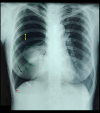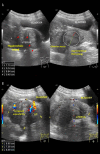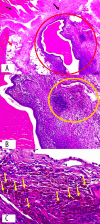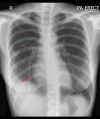Balancing Catamenial Pneumothorax Management with Fertility: Insights from GnRH Agonist Use
- PMID: 40589068
- PMCID: PMC12228424
- DOI: 10.12659/AJCR.947589
Balancing Catamenial Pneumothorax Management with Fertility: Insights from GnRH Agonist Use
Abstract
BACKGROUND Catamenial pneumothorax (CP) is the most common manifestation of thoracic endometriosis syndrome, typically managed with hormonal therapy to suppress ovarian function and prevent recurrence. However, this approach conflicts with pregnancy planning, creating a therapeutic dilemma. While previous reports have discussed CP management, limited evidence exists on long-term strategies that balance disease control with fertility preservation. This case report discusses the use of a GnRH agonist as an alternative to conventional hormonal therapy, demonstrating its potential to delay CP progression while maintaining reproductive potential. CASE REPORT A 37-year-old woman, P0A0, presented with shortness of breath and a history of dysmenorrhea. A decade earlier, she had been diagnosed with pelvic endometriosis and a similar pneumothorax episode. She declined continuous hormonal therapy to preserve fertility and was instead treated with a gonadotropin-releasing hormone (GnRH) agonist. Ten years later, she developed CP and underwent pleurodesis with excision of endometriosis implants. Her postoperative course was uneventful, and she resumed pregnancy planning. This outcome aligns with emerging evidence suggesting that GnRH agonists offer prolonged CP control without compromising fertility, contrasting with the higher recurrence rates seen in patients who do not receive medical management. CONCLUSIONS This case demonstrates that prolonged CP control is feasible using a GnRH agonist, providing an alternative to continuous hormonal therapy in women prioritizing fertility. Future research should focus on defining the optimal duration of GnRH agonist treatment, identifying patient selection criteria, and evaluating long-term reproductive outcomes in CP patients who do not receive standard hormonal suppression.
Conflict of interest statement
Figures










Similar articles
-
Oral medications including clomiphene citrate or aromatase inhibitors with gonadotropins for controlled ovarian stimulation in women undergoing in vitro fertilisation.Cochrane Database Syst Rev. 2017 Nov 2;11(11):CD008528. doi: 10.1002/14651858.CD008528.pub3. Cochrane Database Syst Rev. 2017. PMID: 29096046 Free PMC article.
-
Treatments for seizures in catamenial (menstrual-related) epilepsy.Cochrane Database Syst Rev. 2021 Sep 16;9(9):CD013225. doi: 10.1002/14651858.CD013225.pub3. Cochrane Database Syst Rev. 2021. PMID: 34528245 Free PMC article.
-
Gonadotrophin-releasing hormone antagonists for assisted reproductive technology.Cochrane Database Syst Rev. 2016 Apr 29;4(4):CD001750. doi: 10.1002/14651858.CD001750.pub4. Cochrane Database Syst Rev. 2016. PMID: 27126581 Free PMC article.
-
Levonorgestrel-releasing intrauterine device (LNG-IUD) for symptomatic endometriosis following surgery.Cochrane Database Syst Rev. 2021 Dec 20;12(12):CD005072. doi: 10.1002/14651858.CD005072.pub4. Cochrane Database Syst Rev. 2021. PMID: 34928503 Free PMC article.
-
Clomiphene citrate in combination with gonadotropins for controlled ovarian stimulation in women undergoing in vitro fertilization.Cochrane Database Syst Rev. 2012 Nov 14;11:CD008528. doi: 10.1002/14651858.CD008528.pub2. Cochrane Database Syst Rev. 2012. Update in: Cochrane Database Syst Rev. 2017 Nov 02;11:CD008528. doi: 10.1002/14651858.CD008528.pub3. PMID: 23152261 Updated.
References
-
- Aljehani Y. Catamenial pneumothorax. Is it time to approach differently? Saudi Med J. 2014;35(2):115–22. - PubMed
Publication types
MeSH terms
Substances
Supplementary concepts
LinkOut - more resources
Full Text Sources
Medical
Miscellaneous

